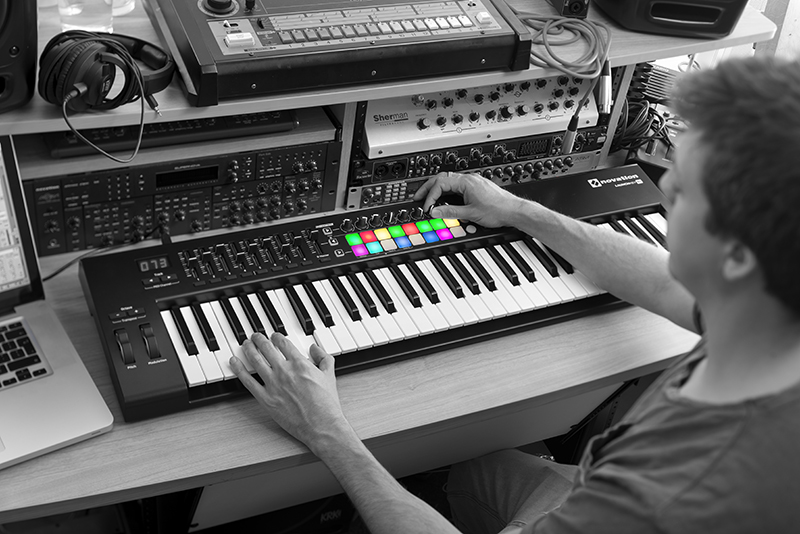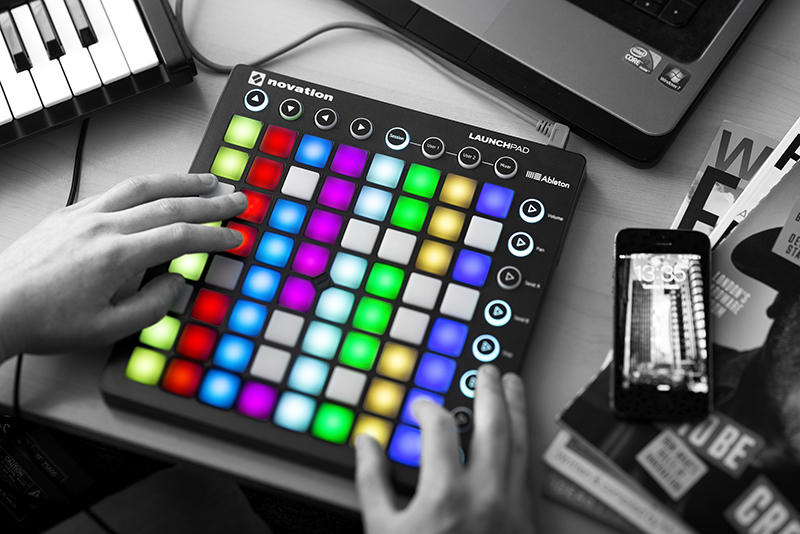Review: Novation Launchpad and Launchkey 61
Novation's mainstays get an RGB LED revamp.

Novation’s Launchpad—which has now expanded to Pro, Mini, and app versions—has been a staple in the Ableton world (and the rest of the DAW world, for that matter) for many years now. Aiming at Ableton’s session view, and with a simplistic approach to clip launching, control, and integration, the unit quickly became a must-have device for producers and live performers; the very modest retail price was the icing on the cake. In 2013, Novation then introduced its Launchkey range, featuring a Mini version, as well as the 25, 49, and 61-key units. The Launchkeys are a hybrid of sorts, fusing pads, keys, knobs, and faders for an altogether more complete unit. This year, Novation decided to give them all a revamp, with all the previously mentioned units now featuring RGB LED backlit pads.
How they Look
Upon unboxing, I noticed that both the Launchpad and the Launchkey 61 are made of a quite sturdy, albeit very light, plastic—the Launchpad weighs in at 1.5 pounds, with the Launchkey 61 at around 20 pounds. Both units feel right at home sitting on a desk, they both have molded rubber bottoms which sit perfectly flat and stick to most surfaces, causing very minimal movement when in use. One problem with the Launchkey—and this would relate to most bedroom producers—was its length. At nearly 40 inches, the unit didn’t leave much room for anything else on a standard size desk. The Launchpad, on the other hand, sits at a very portable and small, 9.5 x 9.5 inches, allowing for easy transportation and storage.
Once plugged in via the USB bus powers, you’ll immediately notice that both unit’s eye-catching RGB LEDs light up, giving a glimpse into the possibilities available when playing live. The Launchpad features an 8×8 grid of pads, which can be used to launch clips, play drum racks and instruments, and control mixer settings, and with the RGB update, the pads now match, color for color, the clips in your Ableton session. This also applies to the Launchkey’s 16 pads, taking the both unit’s integration with Ableton even further and allowing for easy experimentation with arrangements and instruments—the RGB update, when color coded correctly, is a godsend when playing live, drastically minimizing the risk of hitting the wrong clip, not to mention allowing for a more engrossing show for the audience.

How they work
Both units are completely class-compliant, which means that you can just “plug and play” with no installation necessary on any Mac or Windows—the units also work seamlessly with iOS, although a powered USB hub is needed, as well as a camera connection kit or a lightning to USB camera adapter. The Launchpad and Launchkey are also exclusively connected and powered by USB. This definitely isn’t a deal breaker, but it would be a nice inclusion for the units to include five-pin MIDI sockets for the possibility of controlling hardware.
Although the two units do share overlapping functions, there are clear areas where each stand out. The Launchpad’s 8 non-assignable function buttons running horizontally across the top of the unit act as its control center, allowing for fast, responsive, and easy access to the session view, mixer controls, and the two user modes. Its primary use, and where it really excels, is in Ableton’s session view launching clips. In mixer mode, the Launchpad allows you to control volume, panning, and sends and returns—although, when controlling the volume, it’s not as accurate as a fader would be, with the volume taking rather large steps up or down. The Launchpad’s two user modes feature the most flexibility, sending MIDI data and allowing you to play drum racks and instruments, MIDI-map to control effects, and sequence and control mostly any Max4Live device. The only gripe in regards to the user modes is that the pads are not velocity sensitive, but again, it’s not definitely not a deal breaker.
The very small downfalls of the Launchpad were made completely irrelevant when used in conjunction with the Launchkey, its main functions stepping in to create a true production hub. The 16 pads on the Launchkey are velocity sensitive and, like the Launchpad, are used for instrument control or launching clips. Novation’s “InControl” feature takes the Launchkey’s functionality much deeper. When on, “InControl” automatically maps its pads, faders, and knobs to the corresponding clips, track volume faders, and the selected instrument/effect controls, respectively. When “InControl” is off, the pads, faders, and knobs can be mapped to whatever you see fit. It can also be toggled on or off mid recording, which essentially doubles the control features available at any one time. The synth-style keyboard’s action is light and fast, and the semi-weighted keys are also velocity sensitive, but with no aftertouch. The knobs and faders feel solid and smooth, and a small LED display shows the value of the current parameter being controlled.
Both units come bundled with extras, including Ableton Live Lite, Novation’s Bass Station and V-Station VSTs, and a good chunk of samples from Loopmasters.
The Bottom Line
Both units are well made, well thought-out controllers for modern DAWS and the update to RGB pads only accentuates this. It’s hard to go past the Launchpad for its price, ease of use, and functionality in the live space. And if you’re looking for the perfect all-in-one production hub, the Launchkey is a safe and sure bet although, in my opinion, the 61 is too long to be compatible for most home-studio set ups. The Launchkey 41 has exactly the same features—and at 10 inches shorter, is much more practical.
Launchpad MSRP $219.99
Launchkey 61 MSRP $299.99

